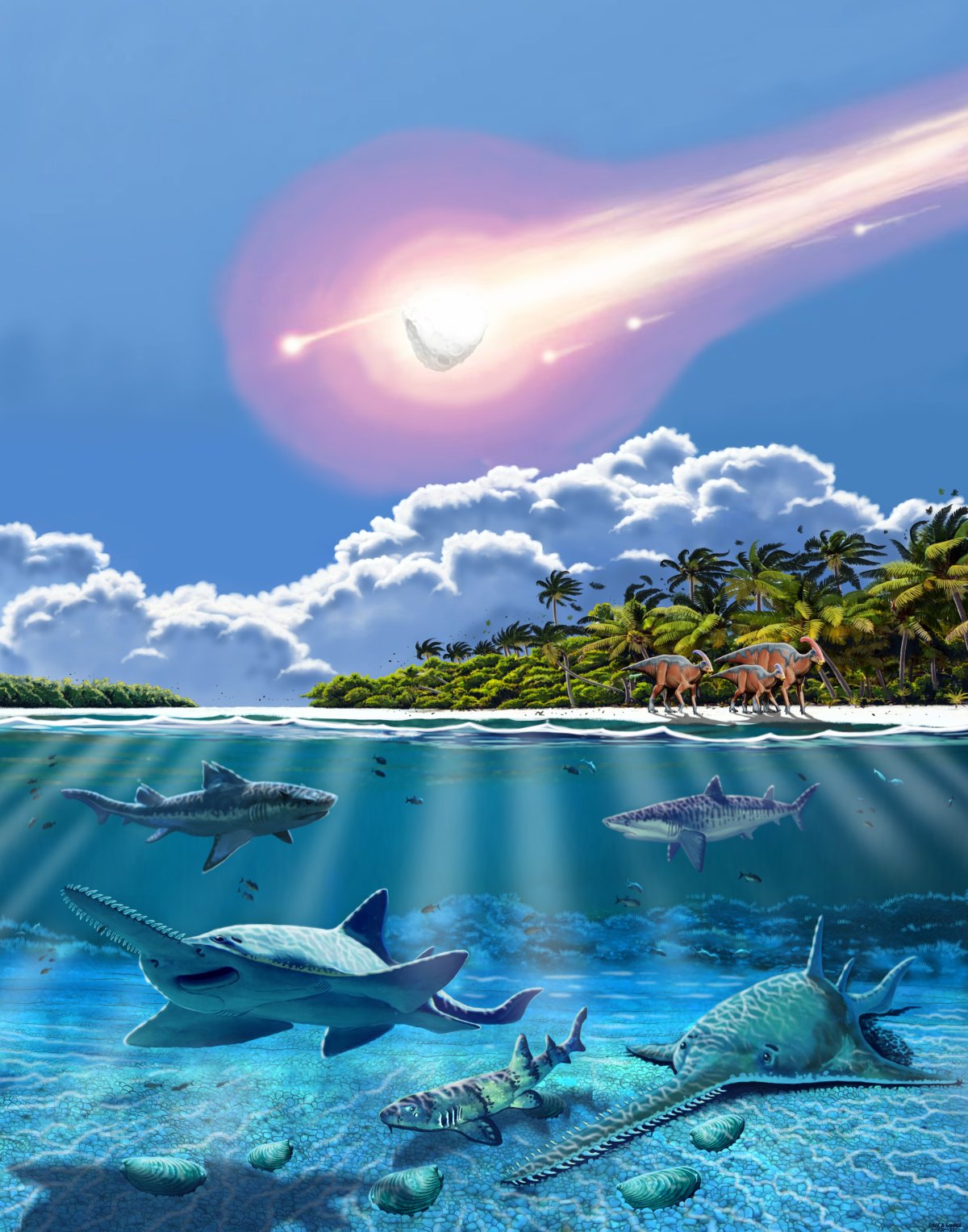Sharks have roamed the Earth's oceans for more than 400 million years. In the process, the animals have survived five mass extinction events, including the one that wiped out the dinosaurs.
This latter extinction event occurred around 66 million years ago, marking the end of the Cretaceous period. It has been linked to the impact of a giant asteroid that smashed into the Earth.
The Cretaceous-Paleogene (K-Pg) mass extinction event, as it is known, sparked drastic ecological changes around the world. This eventually led to the extinction of approximately 55-76 percent of the planet's species.
But how did sharks as a group manage to survive this catastrophic event? A study published this week in the journal Science has shed new light on this issue.

The study analyzed a huge database of global fossil data to examine how elasmobranch species—i.e. sharks, skates and rays—were affected by Earth's last major mass extinction event.
Researchers know relatively little about how the event altered marine ecosystems in comparison to how those on land were affected. The latest study goes some way to addressing this knowledge gap.
"Elasmobranchs are an iconic group of marine vertebrates, yet their evolutionary history is actually still poorly known," Guillaume Guinot, an author of the study from the Institut des Sciences de l'Evolution de Montpellier at the University of Montpellier in France told Newsweek.
"In parallel, understanding the consequences on the marine life of the last mass extinction that occurred 66 million years ago is among the hot topics in paleontology."
Previous studies have shown that this event severely affected all links in the marine food chain. But most fine-scale studies have been carried out on marine invertebrates. Knowledge of the impact of this extinction on vertebrate groups is comparatively scarce.
Guinot and colleagues compiled a database of elasmobranch fossils representing 675 shark, skate and ray species that lived around the time of the K-Pg.
Their analysis found that there was a substantial loss of elasmobranch species following the event. Overall, elasmobranch species declined by more than 62 percent and did not fully recover in the Paleocene period, which spanned around 66 to 56 million years ago. For all shark species, the percentage that went extinct was around 59 percent compared to 72 percent for rays.
But the researchers found that patterns of extinction varied. For example, rays as a group and elasmobranch species that fed on shelled prey (referred to as "durophagous"), as well as more ancient shark species, suffered the highest levels of extinction.

Other sharks and non-durophagous species seemed to fare better and experienced a more rapid recovery following the extinction event. Those species that lived in the open ocean with large geographic ranges and those that were restricted to higher latitudes also tended to have higher survival rates.
"Our results suggest that generalist species show higher survival, while those that developed specializations like durophagous species and top predator sharks show higher extinction than others," Guinot said.
"In addition, our analyses put forward the effect of geographic range on survival: species with large geographic ranges were more likely to go through the extinction event and species living in high latitude settings had much higher survival rates."
The authors showed that long-lived shark species—those that appeared long before the extinction—had a higher extinction probability than younger species.
"This, referred to as 'age-dependent extinction,' suggests some kind of lack of evolutionary novelty for these 'older' species, which might have hampered recovery after the environmental upheavals of the K-Pg event," Guinot said.
The diversity of sharks has also likely played a role in their persistence over such a long period of time.
"I think it is safe to say that it is partly because sharks are able to exploit different parts of the water column—from deep, dark oceans to shallow seas, and even river systems. They eat a wide variety of food, such as plankton, fish, crabs, seals and whales," Emma Bernard, a curator of fossil fish at the Natural History Museum in London, who was not involved in the study, said in an article published on the institution's website.
"This diversity means that sharks as a group are more likely to survive if things in the oceans change," she said.
Guinot said it was important to note that the authors of the Science study could only infer ecological features of extinction victims and survivors based on their teeth.
Elasmobranch species belong to a larger group known as cartilaginous fishes or Chondrichthyans. Teeth represent the vast majority of fossils that we have for this group.
"Cartilage does not preserve as well as bone, however, [Chondrichthyans] shed and replace their teeth continuously throughout their life. Hence, there are possibly several other factors that favored survival or extinction that we still cannot infer," Guinot said.
All orders of sharks, skates and rays (except electric rays) were represented in the Cretaceous period and went through the extinction event.
But some went close to complete extinction, such as the rhinopristiformes—the group to which modern guitarfish and sawfish belong—or the skates.
Guinot said the results of the latest study have implications for our understanding of elasmobranch species that are still living today. Around a third of species from this group are currently threatened with extinction, research has shown.
"Therefore, knowing how this group went through the last mass extinction can help provide a profiling of extinction victims and provide clues as to how they recovered from such a biological crisis," Guinot said.
Uncommon Knowledge
Newsweek is committed to challenging conventional wisdom and finding connections in the search for common ground.
Newsweek is committed to challenging conventional wisdom and finding connections in the search for common ground.
About the writer
Aristos is a Newsweek science reporter with the London, U.K., bureau. He reports on science and health topics, including; animal, ... Read more
To read how Newsweek uses AI as a newsroom tool, Click here.








